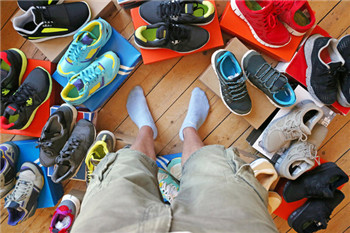
Many runners may be wearing the wrong shoes for their particular stride or the right shoes that were chosen for the wrong reasons, according to a new scientific review about running shoes and injury risks.
ж–°иҝ‘дёҖйЎ№е…ідәҺи·‘йһӢе’ҢеҸ—дјӨйЈҺйҷ©зҡ„科еӯҰз»јиҝ°жҢҮеҮәпјҢи®ёеӨҡи·‘жӯҘиҖ…з©ҝзқҖзҡ„йһӢеӯҗ并дёҚйҖӮеҗҲе…¶зү№жңүжӯҘжҖҒпјҢжҲ–иҖ…пјҢ他们иҷҪ然з©ҝеҜ№дәҶйһӢпјҢдҪҶйҖүжӢ©иҝҷйһӢзҡ„еҺҹеӣ еҚҙе®Ңе…ЁдёҚеҜ№еӨҙгҖӮ
The study helpfully concludes that there is a reliable, scientifically valid way for each of us to pick the right running shoes, but itвҖҷs so simple that most of us ignore it.
иҜҘз ”з©¶её®еҠ©жҲ‘们еҫ—еҮәдәҶиҝҷж ·зҡ„з»“и®әпјҡжҲ‘们жғіиҰҒжҢ‘йҖүеҮәжӯЈзЎ®еҸҜйқ зҡ„и·‘йһӢпјҢеҸҜд»ҘйҒөеҫӘдёҖз§Қ科еӯҰиҖҢжңүж•Ҳзҡ„ж–№жі•пјҢеҸӘжҳҜиҝҷдёӘж–№жі•еӨӘиҝҮз®ҖеҚ•пјҢд»ҘиҮідәҺжҲ‘们еӨ§еӨҡж•°дәәйғҪеҝҪи§ҶдәҶе®ғгҖӮ
The connection between running shoes and running injuries is surprisingly controversial and, from a scientific standpoint, unsettled.
и·‘йһӢдёҺи·‘жӯҘжҚҹдјӨд№Ӣй—ҙзҡ„е…іиҒ”еҮәдәәж„Ҹж–ҷең°е……ж»Ўдәүи®®пјҢ科еӯҰдёҠеҜ№жӯӨд№ҹе°ҡж— е®ҡи®әгҖӮ
Most of us who run have heard that we should choose our shoes based, for the most part, on two broad technical criteria.
и·‘жӯҘзҲұеҘҪиҖ…们еӨ§еӨҡйғҪеҗ¬иҜҙиҝҮйҖүжӢ©и·‘йһӢеӨ§иҮҙиҰҒж №жҚ®дёӨеӨ§жҠҖжңҜж ҮеҮҶгҖӮ
The first is whether and how much our foot pronates, or rolls inward as we land. Orthopedists, coaches and runners long have believed that over- or under-pronation contributes to the risk of running injuries and should be controlled using particular types of shoes.
第дёҖжҳҜеҪ“жҲ‘们足йғЁзқҖең°ж—¶жҳҜеҗҰеӯҳеңЁзҝ»иҪ¬пјҢеҰӮжһңжңүпјҢзЁӢеәҰеҰӮдҪ•гҖӮй•ҝжңҹд»ҘжқҘпјҢйӘЁз§‘еҢ»з”ҹгҖҒж•ҷз»ғе’ҢиҝҗеҠЁе‘ҳйғҪи®ӨдёәпјҢи¶ійғЁеӨ–зҝ»пјҲpronation/over-pronationпјҢжҲ–з§°и¶іиёқеҶ…ж—ӢиҝҮеәҰпјүжҲ–еҶ…зҝ»пјҲunder-pronationпјҢдёҺеүҚиҖ…зӣёеҸҚпјүйғҪеҸҜиғҪдјҡйҖ жҲҗи·‘жӯҘеҸ—дјӨзҡ„йЈҺйҷ©пјҢеә”дҪҝз”Ёзү№е®ҡзұ»еһӢзҡ„йһӢеӯҗжқҘеҠ д»Ҙзҹ«жӯЈгҖӮ
More recently, impact force, or the pounding that we experience with each stride, has also been getting plenty of attention, especially in relation to barefoot running and the question of whether we should wear shoes at all. Some barefoot-running proponents claim that running without shoes or in minimal, slipper-like models somehow changes impacts and substantially reduces the risk for injuries.
иҝ‘жқҘпјҢжҲ‘们跑жӯҘж—¶еҸ—еҲ°зҡ„еҶІеҮ»еҠӣпјҲеҚіи§Ұең°еҸҚеҶІеҠӣпјүд№ҹж—ҘжёҗдёәдәәжүҖе…іжіЁпјҢеңЁж¶үеҸҠиөӨи¶іи·‘жӯҘд»ҘеҸҠжҲ‘们жҳҜеҗҰе°ұдёҚиҜҘз©ҝйһӢзҡ„й—®йўҳдёҠе°Өе…¶еҰӮжӯӨгҖӮдёҖдәӣж”ҜжҢҒиөӨи¶іи·‘жӯҘзҡ„дәәеЈ°з§°пјҢдёҚз©ҝйһӢеӯҗжҲ–иҖ…еҸӘз©ҝжңҖз®ҖеҚ•зҡ„家еұ…йһӢдјҡд»Һжҹҗз§ҚзЁӢеәҰдёҠеҪұе“Қи§Ұең°еҸҚеҶІеҠӣпјҢд»ҺиҖҢеӨ§еӨ§йҷҚдҪҺеҸ—дјӨзҡ„йЈҺйҷ©гҖӮ
But Benno Nigg, the lead author of the new review, and his colleagues were skeptical. An emeritus professor of kinesiology at the University of Calgary in Canada and one of the worldвҖҷs foremost experts on biomechanics, Dr. Nigg wondered whether science really supports the idea that the right shoes can alter and fix someoneвҖҷs running form and lessen injuries.
дёҚиҝҮпјҢж–°иҝ‘иҝҷзҜҮз»јиҝ°зҡ„дё»иҰҒдҪңиҖ…жң¬иҜәВ·е°јж ј(Benno Nigg)е’Ңд»–зҡ„еҗҢдәӢ们еҜ№жӯӨжҢҒжҖҖз–‘жҖҒеәҰгҖӮе°јж јеҚҡеЈ«жҳҜеҠ жӢҝеӨ§еҚЎе°”еҠ йҮҢеӨ§еӯҰ(University of Calgary)зҡ„иҝҗеҠЁеӯҰиҚЈиӘүйҖҖдј‘ж•ҷжҺҲпјҢд№ҹжҳҜдё–з•ҢдёҠдёҖжөҒзҡ„з”ҹзү©еҠӣеӯҰ专家д№ӢдёҖпјҢеҜ№дәҺеҗҲйҖӮзҡ„йһӢеҸҜд»Ҙж”№еҸҳе’Ңзә жӯЈдәәзҡ„и·‘жӯҘе§ҝеҠҝгҖҒеҮҸе°‘дјӨе®іиҝҷз§Қи§ӮзӮ№пјҢд»–еҫҲжҖҖз–‘е®ғжҳҜеҗҰе…·жңүеҲҮе®һзҡ„科еӯҰдҫқжҚ®гҖӮ
So for the new review, which was published last week in The British Journal of Sports Medicine, Dr. Nigg and his colleagues trolled through decadesвҖҷ worth of studies about running injuries, shoes and their relationship.
дәҺжҳҜпјҢеңЁиҝҷзҜҮдёҠе‘ЁеҸ‘иЎЁеңЁгҖҠиӢұеӣҪиҝҗеҠЁеҢ»еӯҰжқӮеҝ—гҖӢ(The British Journal of Sports Medicine)дёҠзҡ„з»јиҝ°дёӯпјҢе°јж јеҚҡеЈ«е’Ңд»–зҡ„еҗҢдәӢ们еӣһйЎҫдәҶиҝ‘еҮ еҚҒе№ҙжқҘе…ідәҺиҝҗеҠЁжҚҹдјӨгҖҒйһӢд»ҘеҸҠиҝҷдёӨиҖ…д№Ӣй—ҙе…ізі»зҡ„з ”з©¶гҖӮ
It soon became clear to the researchers that most of our beliefs about running injuries and shoes are, in fact, myths.
еҫҲеҝ«пјҢз ”з©¶дәәе‘ҳе°ұеҸ‘зҺ°пјҢжҲ‘们关дәҺи·‘жӯҘйҖ жҲҗзҡ„жҚҹдјӨе’Ңи·‘йһӢзҡ„еӨ§йғЁеҲҶи®ӨиҜҶе…¶е®һйғҪжҳҜи°¬и°ҲгҖӮ
Pronation, for instance, does not seem to be a problem requiring correction. In the one large-scale experiment studying pronation, almost 1,000 novice runners, some of whom pronated and some of whom did not, were given the same running shoes and followed for a year.
дҫӢеҰӮпјҢи¶іеӨ–зҝ»дјјд№Һ并дёҚжҳҜдёҖдёӘйңҖиҰҒзҹ«жӯЈзҡ„й—®йўҳгҖӮеңЁдёҖйЎ№з ”з©¶и¶іеӨ–зҝ»зҡ„еӨ§еһӢиҜ•йӘҢдёӯпјҢз ”з©¶дәәе‘ҳеҸ‘з»ҷиҝ‘1000еҗҚи·‘жӯҘж–°жүӢпјҲе…¶дёӯйғЁеҲҶдәәеӯҳеңЁи¶іеӨ–зҝ»пјүеҗҢж ·ж¬ҫејҸзҡ„и·‘йһӢпјҢ并еҜ№д»–们иҝӣиЎҢдәҶдёәжңҹдёҖе№ҙзҡ„йҡҸи®ҝгҖӮ
At the end of that time, many of the runners with normal feet and form вҖ” who did not overpronate вҖ” had become injured, but a much smaller percentage of those who overpronated had been sidelined.
еңЁйҡҸи®ҝжңҹз»“жқҹж—¶пјҢи®ёеӨҡи„ҡеҪўе’Ңе§ҝеҠҝеқҮжӯЈеёёзҡ„и·‘жӯҘиҖ…йғҪеҸ—дјӨдәҶпјҢиҖҢи¶іеӨ–зҝ»зҡ„и·‘жӯҘиҖ…дёӯеҸ—дјӨзҡ„зҷҫеҲҶжҜ”еҲҷе°Ҹеҫ—еӨҡгҖӮ
Dr. Nigg and his colleagues write in their review that this finding suggests вҖңthat a pronated foot position is, if anything, an advantage with respect to running injuries.вҖқ
е°јж јеҚҡеЈ«е’Ңд»–зҡ„еҗҢдәӢ们еңЁиҝҷзҜҮз»јиҝ°дёӯеҶҷйҒ“пјҢиҝҷдёҖз ”з©¶з»“жһңиЎЁжҳҺпјҡвҖңеҰӮжһңйқһиҰҒиҜҙи¶іеӨ–зҝ»еҜ№и·‘жӯҘйҖ жҲҗзҡ„жҚҹдјӨжңүд»»дҪ•еҪұе“Қзҡ„иҜқпјҢеҸҜд»ҘиҜҙиҝҷз§Қе§ҝеҠҝеҸҚиҖҢдёҚе®№жҳ“д»ӨдәәеҸ—дјӨгҖӮвҖқ
Similarly, they found little evidence that forcefully striking the ground causes injuries or that changing or removing your shoes alters those impacts much anyway.
еҗҢж ·пјҢ他们иҝҳеҸ‘зҺ°еҮ д№ҺжІЎжңүиҜҒжҚ®ж”ҜжҢҒи·‘жӯҘж—¶и¶ійғЁз”ЁеҠӣж’һеҮ»ең°йқўдјҡеј•иө·дјӨе®іпјҢжҚўйһӢжҲ–иҖ…и„ұжҺүйһӢеӯҗеҸҜд»Ҙж”№еҸҳи§Ұең°еҸҚеҶІеҠӣзӯүиҜҙжі•гҖӮ
Perhaps most unexpected, running shoes designed to somehow вҖңfixвҖқ someoneвҖҷs running form turned out often to be ineffective and even counter-productive. In a series of studies, when military recruits were assigned running shoes meant to control their particular level of pronation, those soldiers were as likely, or even more so, to sustain running-related injuries than soldiers given shoes at random.
д№ҹи®ёжңҖд»Өдәәж„ҸеӨ–зҡ„жҳҜпјҢдё“дёәвҖңзҹ«жӯЈвҖқдәәзҡ„и·‘е§ҝиҖҢи®ҫи®Ўзҡ„зү№ж®Ҡи·‘йһӢйқһдҪҶеҫҖеҫҖж— ж•ҲпјҢз”ҡиҮіиҝҳдјҡйҖӮеҫ—е…¶еҸҚгҖӮеңЁдёҖзі»еҲ—з ”з©¶дёӯпјҢдёҖйғЁеҲҶж–°е…өйўҶеҲ°еҸҜеҜ№д»–们еҗ„иҮӘзү№е®ҡзҡ„и¶іеӨ–зҝ»ж°ҙе№іеҠ д»ҘжҺ§еҲ¶е’Ңзә жӯЈзҡ„и·‘йһӢпјҢе…¶д»–дәәеҲҷжҳҜйҡҸжңәйўҶйһӢгҖӮз ”з©¶еҸ‘зҺ°пјҢиҝҷдёӨз»„ж–°е…өеҸ—еҲ°и·‘жӯҘзӣёе…ідјӨе®ізҡ„еҸҜиғҪжҖ§зұ»дјјпјҢз”ҡиҮіжңүж—¶еүҚиҖ…иҝҳжӣҙе®№жҳ“еҸ—дјӨгҖӮ
But if shoes are chosen for the right reason, they can reduce injuries, Dr. Nigg and his colleagues concluded after parsing all of the relevant studies.
然иҖҢпјҢе°јж јеҚҡеЈ«е’Ңд»–зҡ„еҗҢдәӢ们еҲҶжһҗдәҶжүҖжңүзӣёе…із ”究еҗҺеҫ—еҮәзҡ„з»“и®әжҳҜпјҡдҫқжҚ®жӯЈзЎ®зҡ„зҗҶз”ұжқҘйҖүжӢ©йһӢеӯҗзЎ®е®һеҸҜд»ҘеҮҸе°‘дјӨе®ігҖӮ
And the right reason does not involve pronation control or impact forces.
иҖҢиҝҷжүҖи°“жӯЈзЎ®зҡ„зҗҶз”ұ并дёҚеҢ…жӢ¬жҺ§еҲ¶и¶іеӨ–зҝ»д»ҘеҸҠеҶІеҮ»еҠӣгҖӮ
What matters, the researchers conclude in their review, is comfort. In one study from 2001 (overseen by Dr. Nigg), researchers asked soldiers to try six shoe inserts, which varied in terms of cushioning, arch height, heel shape, thickness and other variables. The soldiers were asked to pick the one insert that felt the most comfortable to them and wear that insert inside their shoes during their subsequent military training. A separate group of soldiers wore standard footwear as controls.
з ”з©¶дәәе‘ҳеңЁз»јиҝ°дёӯжҖ»з»“йҒ“пјҡе…ій”®зҡ„й—®йўҳеңЁдәҺиҲ’йҖӮгҖӮеңЁ2001е№ҙзҡ„дёҖйЎ№з ”з©¶дёӯпјҲе°јж јеҚҡеЈ«дёәе…¶иҙЈд»»дҪңиҖ…пјүпјҢз ”з©¶дәәе‘ҳиҰҒжұӮеЈ«е…ө们иҜ•з©ҝдәҶеңЁеҮҸйңҮзј“еҶІгҖҒи¶іеј“й«ҳеәҰгҖҒйһӢи·ҹеҪўзҠ¶гҖҒеҺҡеәҰе’Ңе…¶д»–еҸҳйҮҸзӯүж–№йқўдёҚе°ҪзӣёеҗҢзҡ„е…ӯз§ҚйһӢеҶ…жүҳпјҢ并иҰҒжұӮ他们жҢ‘йҖүеҮәиҮӘе·ұи§үеҫ—жңҖиҲ’жңҚзҡ„дёҖз§ҚеңЁйҡҸеҗҺзҡ„еҶӣдәӢи®ӯз»ғдёӯе°Ҷе…¶еһ«еңЁиҮӘе·ұзҡ„йһӢйҮҢгҖӮз©ҝзқҖж ҮеҮҶйһӢзҡ„еҸҰдёҖз»„еЈ«е…өжҳҜз ”з©¶зҡ„еҜ№з…§з»„гҖӮ
After four months, the soldiers wearing the shoes fitted with inserts that felt comfortable to them had a much lower incidence of injury than those wearing standard shoes.
еӣӣдёӘжңҲеҗҺпјҢйһӢеҶ…еһ«жңүд»Ө他们иҮӘе·ұи§үеҫ—иҲ’жңҚзҡ„йһӢеҶ…жүҳзҡ„еЈ«е…өдёӯзҡ„еҸ—дјӨзҺҮиҝңдҪҺдәҺеҸӘз©ҝзқҖж ҮеҮҶйһӢзҡ„еЈ«е…өгҖӮ
This finding makes scientific and common sense, Dr. Nigg said. Our bodies are actually вҖңvery good judgesвҖқ of how each of us should move and run, he said. When we ignore or fight our bodiesвҖҷ natural movement pattern, he said, such as by trying to control pronation, the risk of injury rises.
е°јж јеҚҡеЈ«иЎЁзӨәпјҢиҝҷдёҖз»“жһңж—ўеҗҲд№Һ科еӯҰеҸҲз¬ҰеҗҲеёёиҜҶгҖӮд»–иҝҳжҢҮеҮәпјҢеҜ№дәҺеә”иҜҘеҰӮдҪ•иЎҢеҠЁе’ҢеҘ”и·‘пјҢжҲ‘们иҮӘе·ұзҡ„иә«дҪ“е®һйҷ…дёҠжҳҜвҖңеҫҲеҘҪзҡ„иЈҒеҲӨвҖқгҖӮеҪ“жҲ‘们еҝҪз•ҘжҲ–иҝқжҠ—дәҶжҲ‘们иә«дҪ“зҡ„иҮӘ然иҝҗеҠЁж–№ејҸпјҢжҜ”еҰӮиҜ•еӣҫжҺ§еҲ¶и¶іеӨ–зҝ»пјҢеҸ—дјӨзҡ„йЈҺйҷ©е°ұдјҡеўһеҠ гҖӮ
Instead, he said, we should pay close attention to our bodyвҖҷs opinion about running shoe options.
жҲ‘们еҖ’жҳҜеә”иҜҘеҜҶеҲҮе…іжіЁжҲ‘们зҡ„иә«дҪ“еҜ№и·‘йһӢзҡ„йҖүжӢ©ж„Ҹи§ҒгҖӮ
вҖңTry on four or five pairs,вҖқ Dr. Nigg said. Jog around the store or the block in each.
вҖңжңҖеҘҪиғҪиҜ•з©ҝдёӘеӣӣдә”еҸҢйһӢпјҢвҖқе°јж јеҚҡеЈ«иҜҙпјҢеҲҶеҲ«з©ҝзқҖжҜҸеҸҢйһӢеңЁе•Ҷеә—жҲ–иЎ—еҢәйҮҢж…ўи·‘дёҠдёҖеңҲгҖӮ
вҖңPeople can usually tell right away which shoe feels the most comfortable,вҖқ Dr. Nigg said. вҖңThat is the one to choose.вҖқ
вҖңдәә们йҖҡ常马дёҠе°ұиғҪеҲҶиҫЁеҮәе…¶дёӯе“ӘеҸҢйһӢжңҖиҲ’жңҚпјҢвҖқе°јж јеҚҡеЈ«иҜҙгҖӮвҖңйӮЈе°ұжҳҜзҗҶжғід№ӢйҖүгҖӮвҖқ












